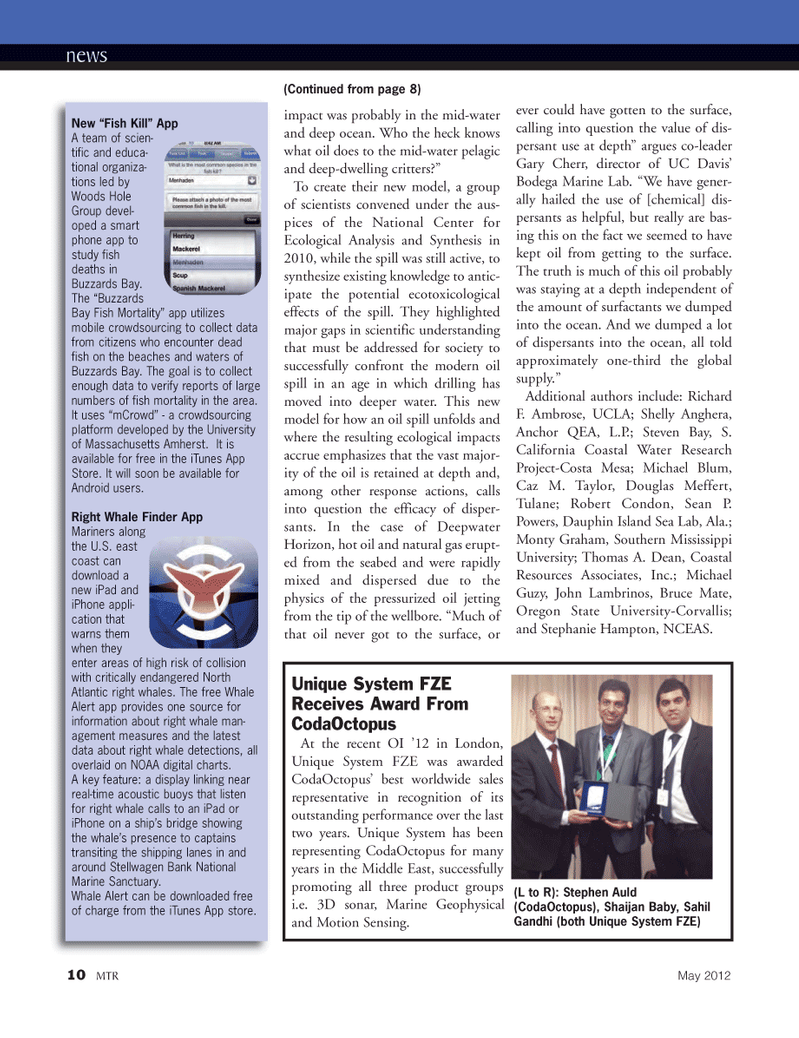
Page 10: of Marine Technology Magazine (May 2012)
Hydrographic Survey
Read this page in Pdf, Flash or Html5 edition of May 2012 Marine Technology Magazine
10MTRMay 2012news New ?Fish Kill? AppA team of scien-tific and educa-tional organiza- tions led byWoods Hole Group devel- oped a smart phone app tostudy fishdeaths inBuzzards Bay. The ?Buzzards Bay Fish Mortality? app utilizes mobile crowdsourcing to collect data from citizens who encounter dead fish on the beaches and waters ofBuzzards Bay. The goal is to collect enough data to verify reports of large numbers of fish mortality in the area. It uses ?mCrowd? - a crowdsourcing platform developed by the Universityof Massachusetts Amherst. It isavailable for free in the iTunes App Store. It will soon be available for Android users. Right Whale Finder AppMariners alongthe U.S. eastcoast candownload anew iPad andiPhone appli-cation thatwarns themwhen theyenter areas of high risk of collision with critically endangered North Atlantic right whales. The free Whale Alert app provides one source for information about right whale man-agement measures and the latest data about right whale detections, alloverlaid on NOAA digital charts. A key feature: a display linking near real-time acoustic buoys that listen for right whale calls to an iPad oriPhone on a ship?s bridge showing the whale?s presence to captains transiting the shipping lanes in andaround Stellwagen Bank National Marine Sanctuary. Whale Alert can be downloaded free of charge from the iTunes App store. impact was probably in the mid-water and deep ocean. Who the heck knows what oil does to the mid-water pelagicand deep-dwelling critters?? To create their new model, a group of scientists convened under the aus- pices of the National Center for Ecological Analysis and Synthesis in 2010, while the spill was still active, to synthesize existing knowledge to antic- ipate the potential ecotoxicological effects of the spill. They highlighted major gaps in scientific understandingthat must be addressed for society to successfully confront the modern oil spill in an age in which drilling hasmoved into deeper water. This new model for how an oil spill unfolds and where the resulting ecological impacts accrue emphasizes that the vast major- ity of the oil is retained at depth and, among other response actions, calls into question the efficacy of disper-sants. In the case of Deepwater Horizon, hot oil and natural gas erupt- ed from the seabed and were rapidly mixed and dispersed due to the physics of the pressurized oil jetting from the tip of the wellbore. ?Much of that oil never got to the surface, or ever could have gotten to the surface, calling into question the value of dis- persant use at depth? argues co-leader Gary Cherr, director of UC Davis? Bodega Marine Lab. ?We have gener- ally hailed the use of [chemical] dis-persants as helpful, but really are bas- ing this on the fact we seemed to have kept oil from getting to the surface. The truth is much of this oil probably was staying at a depth independent ofthe amount of surfactants we dumped into the ocean. And we dumped a lot of dispersants into the ocean, all toldapproximately one-third the global supply.? Additional authors include: Richard F. Ambrose, UCLA; Shelly Anghera, Anchor QEA, L.P.; Steven Bay, S. California Coastal Water Research Project-Costa Mesa; Michael Blum, Caz M. Taylor, Douglas Meffert, Tulane; Robert Condon, Sean P. Powers, Dauphin Island Sea Lab, Ala.; Monty Graham, Southern Mississippi University; Thomas A. Dean, Coastal Resources Associates, Inc.; Michael Guzy, John Lambrinos, Bruce Mate, Oregon State University-Corvallis; and Stephanie Hampton, NCEAS. Unique System FZEReceives Award From CodaOctopusAt the recent OI ?12 in London, Unique System FZE was awarded CodaOctopus? best worldwide sales representative in recognition of its outstanding performance over the last two years. Unique System has been representing CodaOctopus for many years in the Middle East, successfully promoting all three product groups i.e. 3D sonar, Marine Geophysical and Motion Sensing. (L to R): Stephen Auld(CodaOctopus), Shaijan Baby, Sahil Gandhi (both Unique System FZE)(Continued from page 8) MTR#4 (1-17):MTR Layouts 5/7/2012 10:33 AM Page 10

 9
9

 11
11
